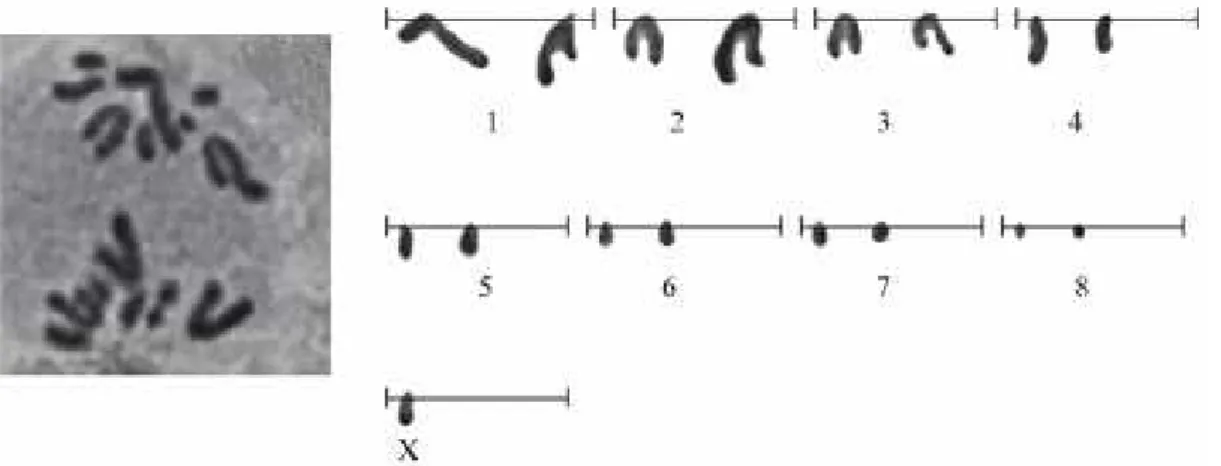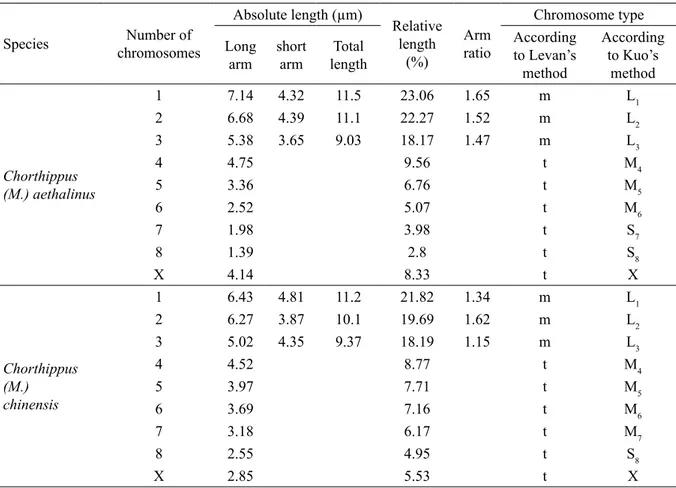31 © 2013 Journal compilation
http://biology.num.edu.mn http://mjbs.100zero.org/ Volume 11(1-2), 2013
Mongolian Journal of Biological
Sciences
ISSN 1684-3908 (print edition)
ISSN 2225-4994 (online edition)
MJBS
Original Ar• cle
Comparative Study on the Karyotype of Two Species of
Megaulacobothrus
Caud., 1921 (Acridoidea)
Dorjsuren Altanchimeg
1, Chen Lin
2, Nonnaizab
21Laboratory of Entomology, Institute of Biology, Mongolian Academy of Science, Ulaanbaatar 210351, Mongolia. E-mail: d_altanchimeg@yahoo.com
2Institute of Life Science and Technology, Inner Mongolia Normal University, Huhhot 014022, China. E-mail: linchen310@126.com; nonnaizb@imnu.edu.cn
Abstract
Key words:
Chromosome,
karyotype, Chorthippus (Megaulacobothrus) aethalinus, Chorthippus (Megaulacobothrus) chinensis
Article information:
Received: 22 Jan. 2012 Accepted: 08 Apr. 2014 Published: 20 Apr. 2014
Correspondence: d_altanchimeg@yahoo. com
Cite this paper as:
The karyotypes of Chorthippus (Megaulacobothrus) aethalinus (Zubovsky, 1899) and Chorthippus (Megaulacobothrus) chinensis Tarbinsky, 1927 were compared by means of the conventional cytogenetic method. The results showed that chromosome numbers of two species were 2n(♂)=17=16+XO, in which three pairs of autosomal and sex chromosomes were terminal chromosomes, and the other fi ve pairs of autosomal ones were metacentric chromosomes, which are the diagnostic characters of
Chorthippus. However, these two species could be identifi ed by the different formulae and the relative length of chromosomes. The chromosome formula of Chorthippus (M.) aethalinus is K(2n,♂)=6m+11t=6L+6M+4S+XO, whereas that of Chorthippus (M.) chinensis is K(2n,♂)=6m+11t=6L+8M+2S+XO. In addition, we found that the location and the relative length of sex chromosomes in the two species were different from each other. Sex chromosome of Chorthippus (M.) aethalinus located at fi fth position and its relative length was equal to 8.33%, whereas that of Chorthippus (M.) chinensis was at eighth position and its relative length was equal to 5.53%. These results showed that signifi cant different karyotype features exist in the two compared species of Chorthippus.
Altanchimeg, D., Lin, Ch., & Nonnaizab. 2013.Comparative study on the karyotype of two species of Megaulacobothrus Caud., 1921 (Acridoidea). Mong. J. Biol. Sci., 11(1-2): 31-34.
Introduction
The subgenus Megaulacobothrus Caudell, 1921 belongs to the genus Chorthippus Fieber, 1852 (Catantopinae, Acrididae, Orthoptera). Chorthippus is one of the largest genera in Catantopinae, and believed to the main group of grasshoppers in the northern China. More than 200 species of this genus were recorded from Europe, Asia, Africa and USA. Up to date, 76 species of the genus including 4 subgenera, such as Megaulacobothrus, Glybtobothrus,
Altrichorthippus, Chorthippus were recorded in China (Zheng & Xi, 1998). The comparison of the karyotypes in grasshoppers not only displays their evolutionary process and trend, but also reveals the
phylogeny and taxonomic status of the species. In addition, it could also provide the scientifi c basis for the pest control (Zhang et al., 2003; Ma et al., 2000). According to literatures, there are about 10,000 species of grasshoppers worldwide, and the chromosomes of the over 1000 species have been analyzed (Ma & Zheng, 1989). Currently, karyotypes of only some species of the families Pamphagidae, Pyrgomorphidae, Oedipodidae and Arcypteridae in China have been reported (Yan, 2001; Yang et al., 2008).
Altanchimeget al. Karyotype of two grasshopper species
32
to grassland. Comparative study on karyotypes of Chorthippus (M.) aethalinus (Zubovsky, 1899) and Chorthippus (M.) chinensis Tarbinsky, 1927 have not been reported. In this paper, we compared the karyotypes ofthese two species for discussing the characteristics of cytotaxonomy and providing the theoretical basis to the classifi cation of grasshoppers.
Material and Methods
The adult grasshoppers were identifi ed by Nonnaizab, which preserved in the Museum of the Inner Mongolia Normal University.
Chorthippus (M.) aethalinus was collected from the meadow near forest in Wulanmaodu soum of Keerqinyouyizhongqi of Xing an meng, Inner Mongolia (August 5, 2009), and Chorthippus (M.) chinensis was collected from the meadow near forest of Bogdkhan mountain in the vicinity of Ulaanbaatar city of Mongolia (July 5, 2009).
After dissecting the alive adult male grasshoppers, their testes were preserved in fi xation solution (ethanol : acetic acid = 3 : 1) for 8-12 hours. Afterwards the tests were transferred to 70% ethanol and stored under 40C until further
processing. Some seminiferous tubules from the testes were stained with Fe-acetic carmine by traditional squash method for 25 minutes, and then prepared glass slides for further observation using the optical microscope (Olympus BH-2).
The fi nal chromosome numbers were determined based on 85% cell division phase as cardinal number. From which, fi ve cells were selected randomly and then took their pictures by digital photomicrography system (Motic-BA200). Furthermore, the chromosome types and lengths were analyzed using Motic Images Advanced 3.2
software. Finally, the karyotypes and ideograms of two species were obtained using Video Test-Karyo 3.1 software. The relative length and arm ratio of chromosomes were calculated by the following formula.
After measuring the length of short and long arms of chromosomes in 5 cells of each species, the relative length and arm ratio were calculated, and the divisions of the chromosome type were determined by the method of Levan et al. (1964) and Kuo et al. (1972).
Results
According to the XO sex-determining mechanism, the chromosome numbers of 95.2% metaphase cells of Chorthippus (M.) aethalinus were 2n(♂)=17=16+XO, whereas the chromosome numbers of 97.3% of Chorthippus (M.) chinensis were 2n(♂)=17=16+XO.
The karyotype parameters including the absolute length, relative length and the arm ratio of two species are shown in Table 1. According to the Levan’s method, two species of Chorthippus have the same chromosome types. The chromosomes #1-3 were metacentric, whereas the chromosomes #4-8 and sex chromosomes were telocentric in these two species (Table 1). The chromosome plates and karyotypes of two Chorthippus are as shown in Figures 1 and 2.
According to the method by Kuo et al. (1972),
Mongolian Journal of Biological Sciences 2013 Vol. 11(1-2) 33
the chromosomes of two studied species could be divided into four groups (Table 1).
(1) Group L: Relative lengths of chromosomes are more than 10%, which called large chromosomes. #1-3 chromosomes of both species belong to this group.
(2) Group M: Relative lengths of chromosomes varied between 5% and 10%, which called medial chromosomes. #4-6 chromosomes in Chorthippus
(M.) aethalinus, and #4-7 chromosomes in
Chorthippus (M.) chinensis belong to this group. (3) Group S: The relative lengths of chromosomes are less than 5%, which called small chromosomes. #7-8 chromosomes of
Chorthippus (M.) aethalinus, and #8 chromosome of Chorthippus (M.) chinensis belong to this group.
(4) Group X represented sex chromosomes Table 1. The karyotype parameters of the two species of Chorthippus Fieb.
Species Number of
chromosomes
Absolute length (µm)
Relative length
(%)
Arm ratio
Chromosome type Long
arm
short arm
Total length
According to Levan’s
method
According to Kuo’s
method
Chorthippus (M.) aethalinus
1 7.14 4.32 11.5 23.06 1.65 m L1
2 6.68 4.39 11.1 22.27 1.52 m L2
3 5.38 3.65 9.03 18.17 1.47 m L3
4 4.75 9.56 t M4
5 3.36 6.76 t M5
6 2.52 5.07 t M6
7 1.98 3.98 t S7
8 1.39 2.8 t S8
X 4.14 8.33 t X
Chorthippus (M.)
chinensis
1 6.43 4.81 11.2 21.82 1.34 m L1
2 6.27 3.87 10.1 19.69 1.62 m L2
3 5.02 4.35 9.37 18.19 1.15 m L3
4 4.52 8.77 t M4
5 3.97 7.71 t M5
6 3.69 7.16 t M6
7 3.18 6.17 t M7
8 2.55 4.95 t S8
X 2.85 5.53 t X
Altanchimeget al. Karyotype of two grasshopper species
34
in both species. There were considerable differences in the relative lengths and positions of sex chromosomes between two species. The sex chromosome of Chorthippus (M.) aethalinus
located in the fi fth position and its relative length was equal to 8.33%, whereas that of Chorthippus (M.) chinensis located in the eighth position and its relative length was equal to 5.53%.
Our study result indicates the both species of
Chorthippus have 17 chromosomes, with the same karyotype formula: K(2n,♂)=6m+11t according to Levan’s method. However, in accordance with Kuo’s method, there was considerable difference between group type formulas of two species. The group type formula of Chorthippus (M.) aethalinus was K(2n,♂)=6L+6M+4S+2XO, while that of Chorthippus (M.) chinensis was K(2n,♂)=6L+8M+2S+XO.
Conclusion
The karyotypes of Chorthippus (M.) aethalinus
and Chorthippus (M.) chinensis were compared for the fi rst time. According to Levan’s method, we found that the chromosome karyotypes were 2n(♂)=17 in both species, in which 3 pairs of them were metacentric, whereas other 5 pairs and sex chromosomes were telocentric, which showing common features for the genus.
However, according to Kuo’s method, the relative length of every chromosome was different from each other. For example, the relative length of chromosome L1 of Chorthippus (M.) aethalinus was apparently longer than that of
Chorthippus (M.) chinensis (23.06% vs. 21.82%), whereas the relative length of chromosome S8 of
Chorthippus(M.) aethalinus was shorter than that of Chorthippus(M.) chinensis (2.8% vs. 4.95%). The chromosome group type of Chorthippus (M.) aethalinus was K(2n, ♂)=6L+6M+4S+XO, whereas that of Chorthippus (M.) chinensis was K(2n,♂)=6L+8M+2S+XO.
Although the sex chromosomes of two species of Chorthippus were telocentric in morphology,
their location and relative lengths were different. The sex chromosome of Chorthippus (M.) aethalinus located in fi fth position and its relative length was equal to 8.33%, whereas that of Chorthippus (M.) chinensis located in eight position and its relative length was equal to 5.53%. Thus, our results showed that there are signifi cant differences in the relative lengths of both autosomal and sex chromosomes, and the locations of sex chromosome in two species of
Chorthippus indicating the different hereditary features in these species.
References
Kuo, S. R., Wang, T. T. & Huang, T. C. 1972.
Karyotype analysis of some Formosan gymno- sperms. Taiwania, 17: 66-80.
Levan, A., Fredga, K. & Sandberg, A. A. 1964. Nomenclature for centromeric position on chromosomes. Hereditas,52:201-220. Ma, E. B. & Zheng, Z. M. 1989. Comparison
of karyotypes and chromosome C-bangding patterns in fi ve Oxya species. Acta Entomologica Sinica, 4: 399-405.
Ma, E. B., Ou, X. H., Qiao, G. X. & Zheng, Z. M. 2000. The chromosome study on Acridoidea (Orthoptera) and the systematic comparison among families. Entomotaxonomia, 1: 6-10. Yan, L. 2001. Chromosome karyotype analysis
of four species of Chorthippus in Qinghai.
Entomological Knowledge, 4: 286-290.
Yang, G. H., Mao, B. Y. & Ou, X. H. 2008. Chromosome of two species of short-winged grasshoppers from Cangshan mountain region.
Journal of Chuxiong Normal University, 23: 16.
Zhang, L. S., Zhang, Q. W., Cai, Q. N., Xu, J. & Zhou, M. X. 2003. Insect chromosome research in China: status and perspectives.
Acta Entomologica Sinica, 6: 773-782.
Zheng, Zh. M. & Xi, K. L. 1998. Orthoptera: Acridoidea: Oedipodidae and Arcypteridae.
Fauna Sinica, Insecta, 10: 396-488.

